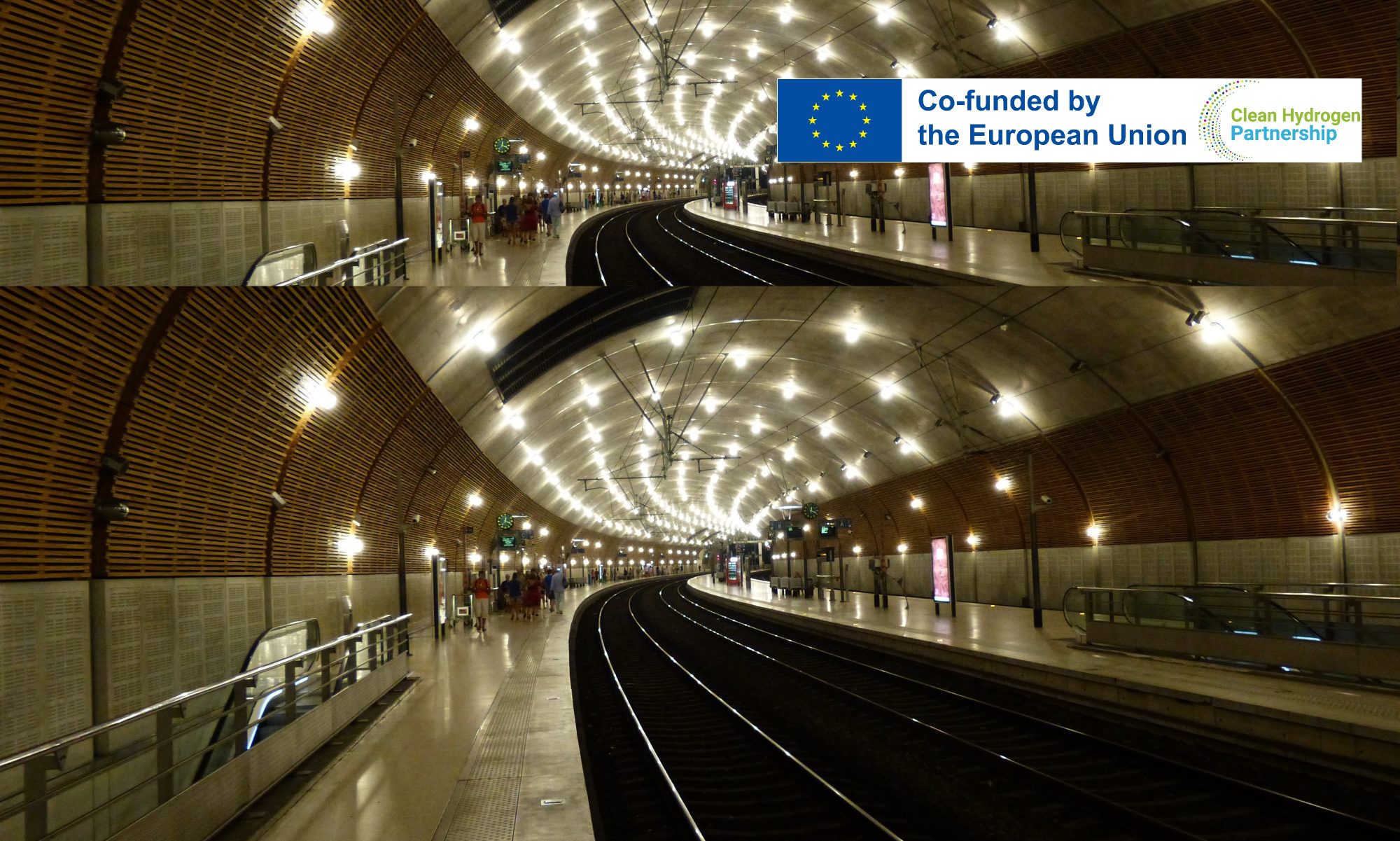We invite you to participate in our dissemination conference presenting conclusions of the project 14-15 July 2022, Brussels, Belgium

HyTunnel-CS consortium is delighted to announce the dissemination conference which will take place in-person 14-15 July 2022 in Brussels, Belgium. The conference will mark end of the project and will present the major public outputs of the project:
- Recommendations for inherently safer use of hydrogen vehicles in underground traffic systems
- Recommendations for Regulations, Codes and Standards
- Harmonised recommendations on response to hydrogen accidents.
Attending the conference will also provide an opportunity to familiarise with other research aspects and conclusions including:
- Technology-disrupting explosion free in a fire self-venting hydrogen storage tank (see this newsletter for details)
- Principles of inherently safer design of hydrogen vehicles for use in confined spaces
- Details of unique large-scale hydrogen release, fire and explosion experiments including real tunnels,
- Engineering and computational tools to predict hazards associated with release and combustion of hydrogen in underground infrastructure and confined spaces
- Quantitative risk assessment methodology for hydrogen vehicles in confined spaces with application examples
Registration is now open and we are waiting for your participation
https://www.eventbrite.es/e/288517703217
All potential users of the project results are invited to attend – hydrogen industry players and hydrogen vehicles OEMs; tunnel authorities, operators, designers and safety officers; members of regulatory bodies and standard developing organisations; fire and rescue services personnel.
Please see the conference agenda for details
Breakthrough safety technology of explosion free in a fire self-venting tank was nominated for the best innovation award 2021
The HyTunnel-CS project developed further the conceived at Ulster University the breakthrough safety technology of explosion free in a fire self-venting hydrogen storage tank without thermally activated pressure relief device (TPRD-less tank). Such tank excludes catastrophic consequences of hydrogen tank rupture in the open space and confined space like tunnel or underground parking. No blast wave, no fireball, no projectiles, no life and property loss. The invention is based on the microleak-no-burst (μLNB) concept. The invention was nominated for the best innovation award in 2021 by Fuel Cell Hydrogen Joint Undertakinig (now operating as Clean Hydrogen Joint Undertaking). It is licensed to the USA. The μLNB tank prototypes with different fibres, resins and liners were successfully tested in fires of different intensity. When in a fire, the melting of liner in the self-venting tank causes numerous microleaks through the composite wall, which is non-hydrogen-tight, thus preventing tank from a rupture. The microleaks could generate only microflames, therefore the technology does not imply hazard distances. The technology validation experiments with 70 MPa self-venting tank prototypes designed by Ulster University are part of the validation experimental programme of partners HSE (UK), CEA (France) and USN (Norway). The partner HSE is testing the performance of a prototype against impinging hydrogen jet fire. The fire testing of other prototypes by partner CEA was already carried out at characteristic for diesel/gasoline fire intensity of 1 MW/m2 using propane gas burner, where the effect of fibre in the composite wall and the effect of fire termination conditions on tank performance were studied. The partner USN is conducting a series of tests where the effect of different liner materials and fibres will be investigated, including in conditions of fire extinction by the water sprinklers to imitate firefighters’ intervention. It is expected that microleaks will continue after fire extinction and hydrogen concentration will decay below the lower flammability limit of 4% of hydrogen in the air in the vicinity of the tank wall. The example of 70 MPa self-venting tank prototype performance in a fire during the test at CEA is presented in the Figure below.


Performance of 70 MPa μLNB tank prototype in a localised fire of 1 MW/m2 with pressure transients inside the tank: (a) – before the leak start, (b) – after the leak start and fuel supply from the propane burner is terminated (resin combustion that could be assisted by hydrogen microleaks is seen).
HyTunnel-CS experimental campaign on hydrogen jet fires and explosions in a real tunnel was successfully completed at CEA
Project partner CEA conducted an extensive experimental campaign on hydrogen jet fires in a real Mortier road tunnel (France), generating unique experimental data and insights into the flame behaviour and thermal hazards:
- Experimental data on flame length extension and radiative heat flux for vertical and downward jet-fires oriented 45° towards the rear of the car
- Validated dimensionless correlation for jet fire flame length which can be used for vertical jet-fire if the height under the vault is sufficient to develop it
- The presence of the car fire (1 MW/m²), mimicked by a burner, was seen to reduce the extent of the vertical jet-fire.

Development of a vertical jet fire from hydrogen storage with orifice diameter 2 mm and initial pressure 700 bar in presence of a burner. Experimental test performed by CEA.
A further experimental campaign gave insights into the blast wave and fireball dynamics following rupture of a high-pressure hydrogen storage tank in a real tunnel:
- For the first time the experiments confirmed the contribution of chemical energy released by hydrogen combustion at contact surface with air to the blast wave strength, which previously was predicted using only analytical and numerical analysis
- Experimental results showed almost no reduction of the blast wave pressure peak throughout the entire tunnel length
- Experiments allowed to study fireball hazards in a tunnel as a function of hydrogen storage tank volume and filling pressure. It was observed that shockwaves reflection on the tunnel walls causes oscillations of the fireball extent, described as the “breathing of the fireball”.

Fireball development in a tunnel. Experimental test performed by CEA.
Have a glance at HyTunnel-CS modelling capabilities
HyTunnel-CS modellers joint their expertise to develop validated model assessing the consequences and hazards from incidents involving hydrogen-powered vehicles in tunnels and similar confined spaces:
- CFD modelling by UU was used to investigate the flammable envelop extent for unignited releases and thermal hazards for ignited hydrogen releases in mechanically ventilated underground car parks. Simulations investigated the effect of a TPRD size and direction on the resulting hazards and compliance with current regulations
- UU has used CFD modelling to assess the blast wave and fireball dynamics after hydrogen tank rupture in a tunnel
- Modelling of unignited hydrogen releases in a tunnel by NCSRD showed that the tunnel slope has a negligible effect on the hydrogen flammable envelop shape
- Benchmark studies were used to assess the effect of mechanical ventilation on a flammable envelop extent
- CFD/FEM modelling by DTU and UU were used to provide insights into the interaction of large hydrogen jet-fires and blast wave from hydrogen high-pressure tank rupture with tunnel structures
- Computational effort was also dedicated to the analysis of prevention and mitigation techniques. As an example, CFD study by NCSRD demonstrated attenuating effect of water mist on the overpressure from deflagration of non-uniform hydrogen-air clouds
- … And many more… Check out HyTunnel-CS deliverables reporting all the project results!

CFD simulations of jet fires in underground car park: effect of TPRD diameter on size and height of hot combustion products cloud, TPRD orientation downward and at 45° to vertical.
Stay tuned on the progress of HyTunnel-CS experiments!
Pro-Science partners performed extensive experimental research on the mitigation of hydrogen explosion consequences. Results demonstrate capability of different absorbing materials, water spray and water mist to attenuate shock waves.

Shock wave propagation from the combustion unit used in PS tests.
HSE and DTU are currently conducting experiments to investigate the effect of hydrogen jet fires on the erosion of tunnel road and lining materials. Test results will provide essential information on the potential structural degradation and concrete spalling for real scale hydrogen jet fires with storage pressure up to 700 bar. Advanced examining techniques are being employed to assess the extent of damage on test samples, e.g. the laser scan analysis demonstrated in the Figure below.

Analysis of the damage extent from a hydrogen jet fire on concrete sample without polypropylene fibres. HSE Test.
Visit HyTunnel-CS Open Data repositories and resources!
The extensive knowledge and scientific findings generated within HyTunnel-CS are available through different means including:
- Open data repositories for experimental data – the results generated by the unique HyTunnel-CS experimental campaigns are available on openly accessible Zenodo platform and partners repositories. Visit our website for the full list!
- Scientific publications – over 30 research studies were either published in peer-reviewed journals and conference proceedings or presented at international meetings and conferences. Click here to see full list!
- Project deliverables – over 20 deliverables are openly available on our website, including reports on our extensive experimental, numerical and theoretical studies.
HyTunnel-CS supports First Responders with the harmonised recommendations on response to hydrogen incidents
The scientific findings obtained in HyTunnel-CS were used to formulate harmonized recommendations for the emergency services on the response, intervention strategies and tactics for hydrogen incidents in tunnels and confined spaces. The recommendations take into account the possibilities and limitations of intervention by fire and rescue services (FRS) today. The main highlights and conclusions include, but are not limited, to the following:
- The potential of high-pressure onboard hydrogen storage tank rupture in a fire should be eliminated or substantially reduced. This would eradicate the most severe hazards (blast wave, fireball, projectiles) and associated risks that the FRS personnel may face during the intervention. Fire risks would be reduced to the level which may be managed well by FRS
- It should be ensured that FRS staff have access to all relevant information about the type of propulsion of vehicles involved in an incident as early as possible to react properly and not to be exposed to unnecessary hazards and risks during the intervention.

Fire fighters’ training at IFA facilities.

